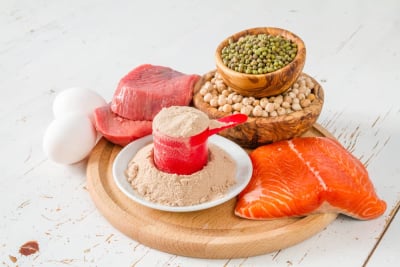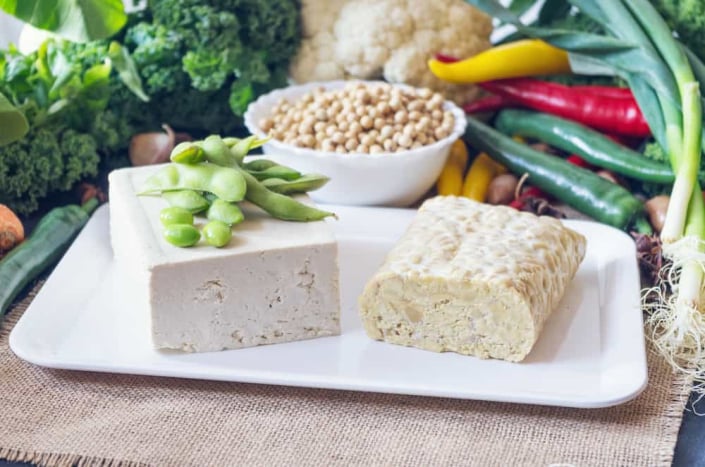What are the functions of protein for the body?
Protein includes nutrients needed for metabolism and body health. These nutrients can be obtained from food, either from animal or vegetable sources. In fact, what is the function of protein and what are the sources of this one nutrient?
What is the function of protein?

Protein is a nutrient whose main function is to repair cell tissue so that it can work properly. These nutrients are found throughout the body including bones, skin, muscles and hair. That said, about 20% of the human body is made up of protein.
One of the most important functions of protein is to produce enzymes and hormones to help maintain the function of cells and organs in the body.
Enzymes work by driving chemical reactions and hemoglobin that carry oxygen into the blood, while hormones keep the body healthy and don’t get sick easily.
In addition, protein also has a function to build cells and tissues in the body, boost the immune system, and repair damaged body cells.
Proteins are made up of building blocks called amino acids. There are about 20 types of amino acids, 9 of which are essential, while the remaining 11 are non-essential. Amino acids can be produced by the body without the need for food intake.
Unfortunately, the amino acids that the body produces are non-essential, so you have to take them from other sources to get essential amino acids.
The nine essential amino acids consist of:
- histidine,
- isoleucine,
- leucine,
- lysine,
- methionine,
- phenylalanine,
- threonine,
- tryptophan, and
- valine.
You can get all of these types from consuming foods that contain animal and vegetable protein.
Each person’s daily protein intake needs vary. Usually, the adequacy of protein substances for women is 56-69 grams per day, while men need 62-66 grams per day.
However, this rule can be readjusted according to your age. The need for children is usually less than for adults.
From what foods can these nutrients be obtained?
Below are various types of food that you can consume as a source of protein which are divided into two types, namely animal protein and vegetable protein.
Source of animal protein

Amino acids in animal protein are complete essential amino acids. Its structure is almost similar to the amino acids in the body. Meanwhile, food sources of vegetable protein do not have as much essential amino acids as the amino acids from animal protein.
That is why, the better absorption value of amino acids, namely those that come from animal food sources. What animal-based foods do you eat well?
1. Chicken eggs
Eggs are a source of animal-containing foods vitamin, mineral, healthy fats, as well antioxidants. One chicken egg contains 6 grams of protein and 78 calories.
2. Lean chicken and beef
Chicken breast is very easy to cook, provided you can cook it properly. The protein content contained in 1 skinless chicken breast is 53 grams, while beef is 22 grams.
3. Cottage cheese
This type of cheese is made from cow’s milk and tends to be very low in fat and calories. This cheese contains calcium, Phosphor, selenium, vitamin B2, as well as vitamin B12. A cup of cottage cheese with 2% fat provides 27 grams of proteinand 194 calories.
4 Yogurt and milk
Yogurt and milk are foods that taste delicious, have a soft texture, and are rich in nutrients. Yogurt weighing 170 grams contains 17 grams of protein and 100 calories. Meanwhile, a cup of milk with 1 percent fat contains 8 grams of protein.
5. Tuna
Tuna fish has low fat and calories so it is good to eat. Like other fish, tuna is rich in nutrients acid omega-3 fats. In 1 ounce of tuna contains 30 grams of protein and 157 calories.
Source of vegetable protein

No less than food sources obtained from animals, vegetable protein sources from plants such as soybeans, kidney beans, and various other legumes also have many functions.
Vegetable protein sources have a function to reduce the risk of exposure type 2 diabetes, maintain body weight, and reduce the risk of heart disease. Where can these nutrients come from?
1. Almonds
Almonds are one of the most popular types of nuts because they contain important nutrients including fiber, vitamin E, and manganese magnesium. The protein content in almonds is 6 grams per 1 ounce.
2. Wheat
Wheat is also one of the healthiest foods because it contains lots of good fiber, magnesium, manganese, vitamin B1 and several other nutrients. The protein content contained in raw wheat is 13 grams and 303 calories.
3. Lentils
Lentils are a nutritious food source where each cup contains 18 grams of protein, providing 230 calories. Additionally, lentils are a good source of fiber and minerals such as iron, phosphorus, thiamin, and folate.
4. Broccoli
Broccoli is a vegetable that contains 2.8 grams of protein in each cup. In addition, broccoli is rich in vitamin C and vitamin K which can reduce the risk of cancer.
What happens when the body lacks protein?

As explained above, this macronutrient has many benefits for the body. If the body lacks protein, there will be several health problems that can come up.
You may get sick more easily. Because, when you lack protein intake, the production of white blood cells will decrease. As a result, the body becomes more susceptible to infection with germs and viruses that carry disease.
Plus, the lack of this substance will also make the wound take longer to heal. This can happen, because protein is needed to heal damaged cells and build new tissue and skin.
In addition, deficiency of these nutrients can cause dry skin problems, nails are dull and nails break easily, changes in hair texture, so that hair is easier to fall out.
In fact, some people have edema. Edema is a buildup of fluid in the tissues and cavities of the body, causing swelling.
This condition occurs because the protein that is supposed to help regulate and maintain fluid balance in the body is not available. This swelling often occurs in the stomach, hands, ankles and feet.
After knowing how important protein functions in the body, you must meet their daily needs. But again, the fulfillment of nutrition should be done in moderation without overdoing it.
Excess protein can also be dangerous. A high protein diet that contains lots of red meat and high amounts of saturated fat puts you at a higher risk of developing kidney stones, heart disease, and colon cancer.
Therefore, eat protein foods in the amount that suits your body’s needs.
Hello Health Group does not provide medical advice, diagnosis or treatment.